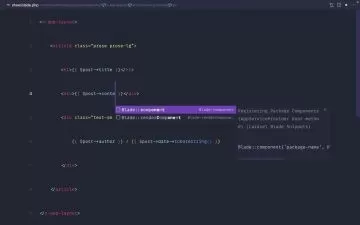Write PHP Like a Pro: Build a PHP MVC Framework From Scratch
Dave Hollingworth
6:38:36
Description
Write faster, easier to maintain, more secure PHP websites by creating your own Model View Controller framework
What You'll Learn?
- Efficiently organise your PHP code into models, views and controllers
- Separate application code (PHP) from presentation code (HTML)
- Learn concepts like dependency injection, templating and middleware
- Best practices for handling errors and exceptions in PHP
- How frameworks like Laravel or CodeIgniter work
- Have pretty URLs instead of PHP filenames
- Object-oriented (OO) techniques such as inheritance, interfaces, abstract classes and more
Who is this for?
What You Need to Know?
More details
DescriptionMost modern PHPÂ development uses a framework like Laravel or CodeIgniter. However, the jump from using basic PHPÂ to using a framework can be difficult. This course bridges that gap.
Frameworks can make your PHP projects faster, easier to write and maintain, and more secure.
Learn to structure your PHP Code like a professional by building a PHP MVC framework from scratch.
Learn how to efficiently organise your code
Separate application code (PHP) from presentation code (HTML)
Have pretty URLs instead of PHPÂ filenames
Develop advanced routing using regular expressions
Learn concepts like dependency injection, templating and middleware
Use object-oriented (OO) techniques such as inheritance, interfaces, abstract classes and more
Develop a full CRUDÂ application using the MVCÂ pattern
The essential skills required to understand and use a PHPÂ MVCÂ framework.
Developing PHPÂ applications is faster and more secure if you use a framework. Learning how to use an MVC framework puts a very powerful tool at your fingertips. By developing your own from scratch, you'll gain an understanding of just how each component works.
Frameworks like Laravel, Symfony and CodeIgniter all use the MVC pattern, so understanding how an MVC framework is put together will give you a strong background to more easily learn frameworks such as these.
Content and Overview
This course is designed for developers who know PHP but don't know how to use a framework. I designed the course for developers who want to develop full, feature-rich applications quickly and easily. Learning the techniques on this course will enable you to write web applications using the framework you build, but also learn frameworks like Laravel much more easily.
Suitable for all PHPÂ developers, you'll start by learning the basics of a PHPÂ MVC framework.
You'll learn how to organise your code into models, views and controllers, and how to work efficiently with them.
We'll build a full web application from scratch, with each concept explained in detail at every stage.
Throughout the course, we'll build code that you can reuse in all your projects.
All the source code developed in the lectures is available to download.
All the time we'll adhere to industry standards and best practices.
When you complete the course you'll be able to use your framework to create fast, flexible web applications, with all the features a modern web application requires.
Complete with all the code shown in the lectures, you'll be able to work alongside the instructor and will receive a verifiable certificate of completion upon finishing the course.
Also, at all times throughout the course you have access to the instructor in the Q&A section to ask for help with any topic related to the course.
Enrol now and become a master of PHPÂ MVC frameworks!
Who this course is for:
- This PHP MVC course is meant for those who already know PHP but want to know how they can improve their code by using a framework. This course is not for you if you don't already know PHP.
- The gap between learning PHP and using a framework can be large - if you've just learnt PHP and you're wondering what the next step might be, this course is for you.
Most modern PHPÂ development uses a framework like Laravel or CodeIgniter. However, the jump from using basic PHPÂ to using a framework can be difficult. This course bridges that gap.
Frameworks can make your PHP projects faster, easier to write and maintain, and more secure.
Learn to structure your PHP Code like a professional by building a PHP MVC framework from scratch.
Learn how to efficiently organise your code
Separate application code (PHP) from presentation code (HTML)
Have pretty URLs instead of PHPÂ filenames
Develop advanced routing using regular expressions
Learn concepts like dependency injection, templating and middleware
Use object-oriented (OO) techniques such as inheritance, interfaces, abstract classes and more
Develop a full CRUDÂ application using the MVCÂ pattern
The essential skills required to understand and use a PHPÂ MVCÂ framework.
Developing PHPÂ applications is faster and more secure if you use a framework. Learning how to use an MVC framework puts a very powerful tool at your fingertips. By developing your own from scratch, you'll gain an understanding of just how each component works.
Frameworks like Laravel, Symfony and CodeIgniter all use the MVC pattern, so understanding how an MVC framework is put together will give you a strong background to more easily learn frameworks such as these.
Content and Overview
This course is designed for developers who know PHP but don't know how to use a framework. I designed the course for developers who want to develop full, feature-rich applications quickly and easily. Learning the techniques on this course will enable you to write web applications using the framework you build, but also learn frameworks like Laravel much more easily.
Suitable for all PHPÂ developers, you'll start by learning the basics of a PHPÂ MVC framework.
You'll learn how to organise your code into models, views and controllers, and how to work efficiently with them.
We'll build a full web application from scratch, with each concept explained in detail at every stage.
Throughout the course, we'll build code that you can reuse in all your projects.
All the source code developed in the lectures is available to download.
All the time we'll adhere to industry standards and best practices.
When you complete the course you'll be able to use your framework to create fast, flexible web applications, with all the features a modern web application requires.
Complete with all the code shown in the lectures, you'll be able to work alongside the instructor and will receive a verifiable certificate of completion upon finishing the course.
Also, at all times throughout the course you have access to the instructor in the Q&A section to ask for help with any topic related to the course.
Enrol now and become a master of PHPÂ MVC frameworks!
Who this course is for:
- This PHP MVC course is meant for those who already know PHP but want to know how they can improve their code by using a framework. This course is not for you if you don't already know PHP.
- The gap between learning PHP and using a framework can be large - if you've just learnt PHP and you're wondering what the next step might be, this course is for you.
User Reviews
Rating
Dave Hollingworth
Instructor's CoursesHi, I'm Dave Hollingworth. I'm an IT trainer and web application developer. I've been writing code and teaching IT for over twenty years.
I've developed enterprise-level applications on platforms ranging from mainframes to mobiles: from my first web application, a quotes system created for a major insurance company back in 1999 - the first of its type in the sector - to interactive learning management systems for online language learning.
I've taught courses ranging from basic use of email to advanced web application development, both online and in-person.
I'm passionate about technology, and love teaching it! I believe it's possible to explain even the most complex subjects in a simple, straightforward way that doesn't confuse the student.
I look forward to welcoming you onto one of my courses!

Udemy
View courses Udemy- language english
- Training sessions 188
- duration 6:38:36
- English subtitles has
- Release Date 2024/04/23










